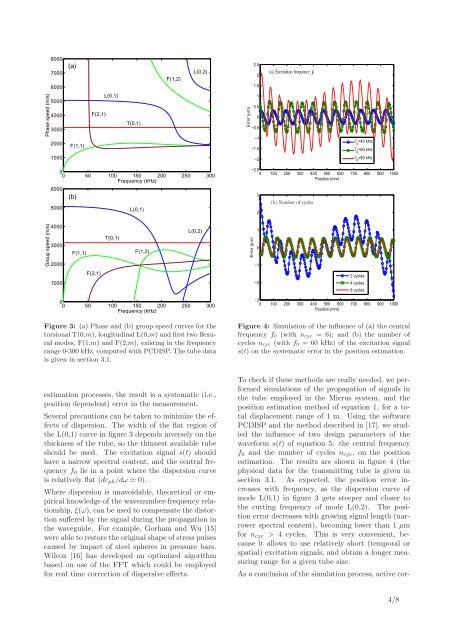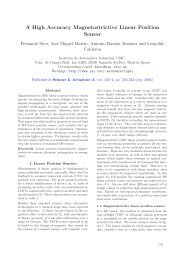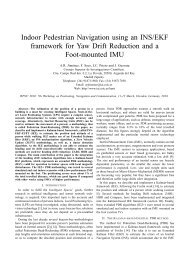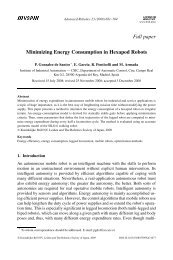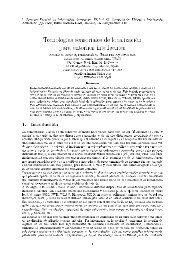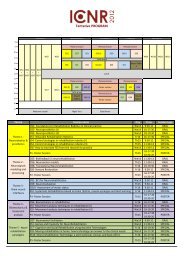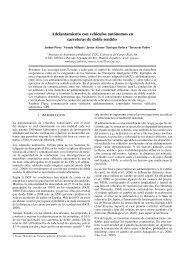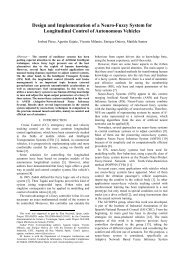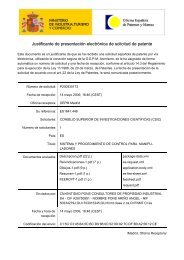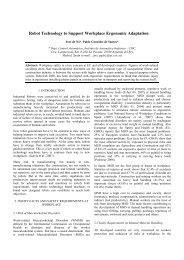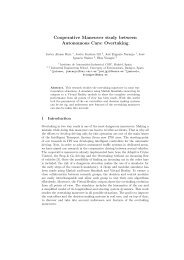Download PDF - Centro de Automática y Robótica
Download PDF - Centro de Automática y Robótica
Download PDF - Centro de Automática y Robótica
You also want an ePaper? Increase the reach of your titles
YUMPU automatically turns print PDFs into web optimized ePapers that Google loves.
Phase speed (m/s)<br />
8000<br />
7000<br />
6000<br />
5000<br />
4000<br />
3000<br />
2000<br />
(a)<br />
F(1,1)<br />
F(2,1)<br />
L(0,1)<br />
T(0,1)<br />
F(1,2)<br />
L(0,2)<br />
Error (µm)<br />
2.5<br />
2<br />
1.5<br />
1<br />
0.5<br />
0<br />
−0.5<br />
−1<br />
−1.5<br />
(a) Excitation frequency f 0<br />
f 0<br />
=40 kHz<br />
f 0<br />
=60 kHz<br />
1000<br />
−2<br />
f 0<br />
=80 kHz<br />
0<br />
0 50 100 150 200 250 300<br />
Frequency (kHz)<br />
6000<br />
5000<br />
(b)<br />
L(0,1)<br />
−2.5<br />
0 100 200 300 400 500 600 700 800 900 1000<br />
Position (mm)<br />
3<br />
2<br />
(b) Number of cycles<br />
Group speed (m/s)<br />
4000<br />
3000<br />
2000<br />
F(1,1)<br />
T(0,1)<br />
F(1,2)<br />
L(0,2)<br />
Error (µm)<br />
1<br />
0<br />
−1<br />
1000<br />
F(2,1)<br />
−2<br />
2 cycles<br />
4 cycles<br />
6 cycles<br />
0<br />
0 50 100 150 200 250 300<br />
Frequency (kHz)<br />
Figure 3: (a) Phase and (b) group speed curves for the<br />
torsional T(0,m), longitudinal L(0,m) and first two flexural<br />
mo<strong>de</strong>s, F(1,m) and F(2,m), existing in the frequency<br />
range 0-300 kHz, computed with PCDISP. The tube data<br />
is given in section 3.1.<br />
−3<br />
0 100 200 300 400 500 600 700 800 900 1000<br />
Position (mm)<br />
Figure 4: Simulation of the influence of (a) the central<br />
frequency f 0 (with n cyc = 6); and (b) the number of<br />
cycles n cyc (with f 0 = 60 kHz) of the excitation signal<br />
s(t) on the systematic error in the position estimation.<br />
estimation processes, the result is a systematic (i.e.,<br />
position <strong>de</strong>pen<strong>de</strong>nt) error in the measurement.<br />
Several precautions can be taken to minimize the effects<br />
of dispersion. The width of the flat region of<br />
the L(0,1) curve in figure 3 <strong>de</strong>pends inversely on the<br />
thickness of the tube, so the thinnest available tube<br />
should be used. The excitation signal s(t) should<br />
have a narrow spectral content, and the central frequency<br />
f 0 lie in a point where the dispersion curve<br />
is relatively flat (dc ph /dω ≃ 0).<br />
Where dispersion is unavoidable, theoretical or empirical<br />
knowledge of the wavenumber-frequency relationship,<br />
ξ(ω), can be used to compensate the distortion<br />
suffered by the signal during the propagation in<br />
the wavegui<strong>de</strong>. For example, Gorham and Wu [15]<br />
were able to restore the original shape of stress pulses<br />
caused by impact of steel spheres in pressure bars.<br />
Wilcox [16] has <strong>de</strong>veloped an optimized algorithm<br />
based on use of the FFT which could be employed<br />
for real time correction of dispersive effects.<br />
To check if these methods are really nee<strong>de</strong>d, we performed<br />
simulations of the propagation of signals in<br />
the tube employed in the Micrus system, and the<br />
position estimation method of equation 1, for a total<br />
displacement range of 1 m. Using the software<br />
PCDISP and the method <strong>de</strong>scribed in [17], we studied<br />
the influence of two <strong>de</strong>sign parameters of the<br />
waveform s(t) of equation 5: the central frequency<br />
f 0 and the number of cycles n cyc , on the position<br />
estimation. The results are shown in figure 4 (the<br />
physical data for the transmitting tube is given in<br />
section 3.1. As expected, the position error increases<br />
with frequency, as the dispersion curve of<br />
mo<strong>de</strong> L(0,1) in figure 3 gets steeper and closer to<br />
the cutting frequency of mo<strong>de</strong> L(0,2). The position<br />
error <strong>de</strong>creases with growing signal length (narrower<br />
spectral content), becoming lower than 1 µm<br />
for n cyc > 4 cycles. This is very convenient, because<br />
it allows to use relatively short (temporal or<br />
spatial) excitation signals, and obtain a longer measuring<br />
range for a given tube size.<br />
As a conclusion of the simulation process, active cor-<br />
4/8


